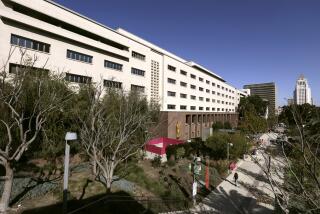Ideas for Art Plaza’s Curtain Unveiled
- Share via
THOUSAND OAKS — It was a long time coming--some members jokingly nicknamed it “the quest for the Holy Grail”--but the city’s Arts Commission has finally wrapped up its recommendations on what to do with the copper curtain, the unpopular artwork strapped to the side of the Civic Arts Plaza.
However, despite the many late-night meetings that arts commissioners dedicated to finding a solution over the past year, the panel’s final recommendations to the City Council leave the quixotic topic far from resolved.
“Some people think the building looks like a prison,” said chairwoman Karen LaFleur, who finished her four-year term on the commission Thursday. “Some think it’s a work of art. The point is, we need to look in a different direction and use some forward thinking heading into the new millennium. The copper curtain needs to be a big part of that.”
The three recommendations are:
* To restore the collection of 2,000 copper strips to the original concept envisioned by its creator, Civic Arts Plaza architect Antoine Predock.
The curtain was supposed to flow to the bottom of the building’s east side, radiating a colorful pattern resembling geologic strata and fluttering in the breeze. But for reasons no one seems able to explain, it was fastened down, left unpainted and cropped into a rectangle.
Despite a legal opinion by City Atty. Mark Sellers that says the curtain is not visual art and Thousand Oaks can alter it regardless of what Predock thinks, commissioners are asking that the architect be part of any new effort. Moreover, they would also like his original drawings, which have yet to surface, to be displayed at City Hall for residents to peruse.
* To hold a contest open to all Ventura County residents to unearth the best idea to improve the curtain. The proposed solutions would be displayed at the Civic Arts Plaza, and residents would fill out ballots to choose their favorite.
Commissioners have already held a series of public meetings and workshops to listen to countless residents’ ideas--including everything from superimposing an oak tree on the artwork to covering the entire building in a Christo-like wrap--but think still more input is needed.
* To wait a year so the Alliance for the Arts, the Civic Arts Plaza’s fund-raising arm, can find a donor to provide the solution--and money--to the copper curtain riddle.
The Arts Commission has only a $10,000 budget to alter the artwork, which would not even cover the scaffolding needed to reach it, and any proposal will require an added source of cash.
Alliance representatives have indicated that several potential donors have inquired about sponsoring the curtain, and they recently asked the commission to put off its decision for a year while they negotiate with the suitors.
Some commissioners expressed skepticism that their efforts will amount to anything. They contend that the City Council does not appear serious about altering the curtain.
“Do I think anything will happen? Probably not,” said Commissioner Bonnie Roth, one of a dozen members who finished their terms on the 15-member panel. “If anything, the council will go with the alliance recommendation.
“My opinion is that the city will never restore the original design, never,” she added. “I just want the issue over with. The council has passed the buck long enough. The $10,000 is a laughable sum, it won’t accomplish anything, and the City Council is going to have to spend more money or find a sponsor willing to risk embarrassment to sponsor the curtain.”
LaFleur and her commission peers were perceived as rabble-rousers by city officials. But she said they often met bureaucratic roadblocks at City Hall in their quest to find out what happened to the curtain in the first place--and they were not afraid to air their frustrations.
As an example of their accomplishments, she pointed to the high attendance at their copper curtain workshop earlier this month, which included a visit by Douglas Friend, an associate in Predock’s firm who explained the architect’s perspective on what went wrong.
Commissioners asked city officials to contact Predock regarding the discussions to alter his creation, but they never did. Finally, a frustrated LaFleur wrote Predock herself.
“Obviously, it’s been frustrating that it’s taken so long to issue the recommendations,” LaFleur said. “But I feel real happy that we were able to contact the artist-architect--whatever you want to call him--and involve the public. I can sleep at night. I know we tried our best to do this.”
More to Read
The biggest entertainment stories
Get our big stories about Hollywood, film, television, music, arts, culture and more right in your inbox as soon as they publish.
You may occasionally receive promotional content from the Los Angeles Times.










